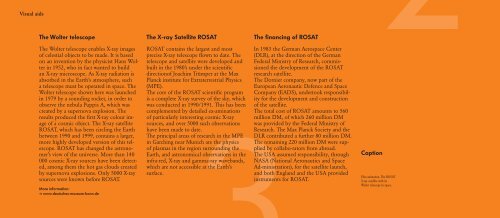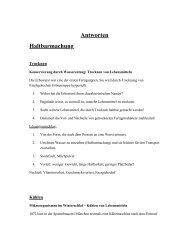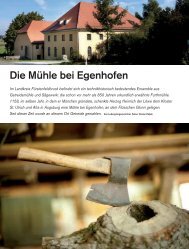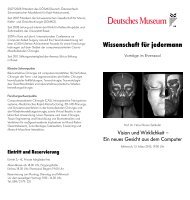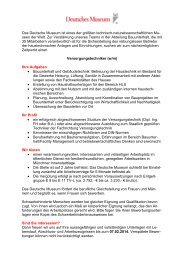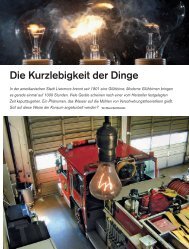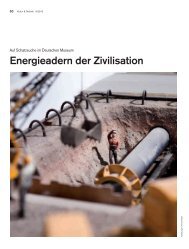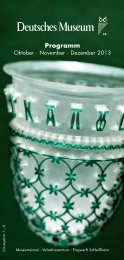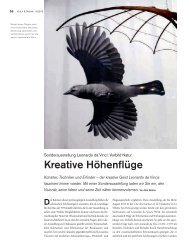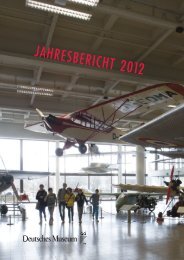Wolter-Teleskop - Deutsches Museum
Wolter-Teleskop - Deutsches Museum
Wolter-Teleskop - Deutsches Museum
Sie wollen auch ein ePaper? Erhöhen Sie die Reichweite Ihrer Titel.
YUMPU macht aus Druck-PDFs automatisch weboptimierte ePaper, die Google liebt.
Visual aids<br />
The <strong>Wolter</strong> telescope The X-ray Satellite ROSAT The financing of ROSAT<br />
The <strong>Wolter</strong> telescope enables X-ray images<br />
of celestial objects to be made. It is based<br />
on an invention by the physicist Hans <strong>Wolter</strong><br />
in 1952, who in fact wanted to build<br />
an X-ray microscope. As X-ray radiation is<br />
absorbed in the Earth’s atmosphere, such<br />
a telescope must be operated in space. The<br />
<strong>Wolter</strong> telescope shown here was launched<br />
in 1979 by a sounding rocket, in order to<br />
observe the nebula Puppis A, which was<br />
created by a supernova explosion. The<br />
results produced the first X-ray colour image<br />
of a cosmic object. The X-ray satellite<br />
ROSAT, which has been circling the Earth<br />
between 1990 and 1999, contains a larger,<br />
more highly developed version of this telescope.<br />
ROSAT has changed the astronomer’s<br />
view of the universe. More than 140<br />
000 cosmic X-ray sources have been detected,<br />
among them the hot gas clouds created<br />
by supernova explosions. Only 5000 X-ray<br />
sources were known before ROSAT.<br />
More information:<br />
www.deutsches-museum-bonn.de<br />
ROSAT contains the largest and most<br />
precise X-ray telescope flown to date. The<br />
telescope and satellite were developed and<br />
built in the 1980’s under the scientific<br />
directionof Joachim Trümper at the Max<br />
Planck institute for Extraterrestrial Physics<br />
(MPE).<br />
The core of the ROSAT scientific program<br />
is a complete X-ray survey of the sky, which<br />
was conducted in 1990/1991. This has been<br />
complemented by detailed ex-aminations<br />
of particularly interesting cosmic X-ray<br />
sources, and over 5000 such observations<br />
have been made to date.<br />
The principal areas of research in the MPE<br />
in Garching near Munich are the physics<br />
of plasmas in the region surrounding the<br />
Earth, and astronomical observations in the<br />
infra-red, X-ray and gamma-ray wavebands,<br />
which are not accessible at the Earth’s<br />
surface.<br />
In 1983 the German Aerospace Center<br />
(DLR), at the direction of the German<br />
Federal Ministry of Research, commissioned<br />
the development of the ROSAT<br />
research satellite.<br />
The Dornier company, now part of the<br />
European Aeronautic Defence and Space<br />
Company (EADS), undertook responsibility<br />
for the development and construction<br />
of the satellite.<br />
The total cost of ROSAT amounts to 560<br />
million DM, of which 260 million DM<br />
was provided by the Federal Ministry of<br />
Research. The Max Planck Society and the<br />
DLR contributed a further 80 million DM.<br />
The remaining 220 million DM were supplied<br />
by collabo-rators from abroad.<br />
The USA assumed responsibility, through<br />
NASA (National Aeronautics and Space<br />
Ad-ministration), for the satellite launch,<br />
and both England and the USA provided<br />
instruments for ROSAT.<br />
Caption<br />
Film animation. The ROSAT<br />
X-ray satellite with its<br />
<strong>Wolter</strong> telescope in space.<br />
2


